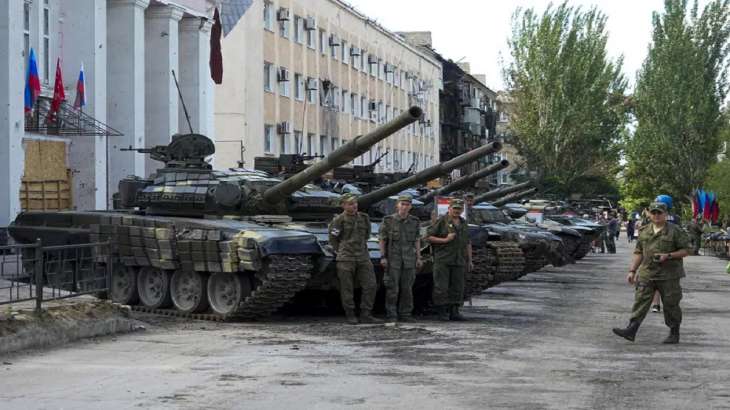
Russia-Ukraine War Update: The Russian army carried out another onslaught of missiles and self-detonating drones on Thursday (Jan 26) in nearly a dozen provinces of Ukraine, causing the year’s first attack-related death in Kyiv and killing at least 11 people in all went.
State Emergency Service of Ukraine spokesman Oleksandr Khorunzhiy announced the death toll in comments on Ukrainian television. He said that at least 11 people were also injured in the attacks.
The attacks followed Russia’s recent pattern of launching widespread attacks every two weeks. However, the latest attack comes a day after Germany and the United States pledged to send high-tech battle tanks to Ukraine in their 11-month war with Russia and give the green light for other allies to do the same.
Kyiv Mayor Vitali Klitschko said one person died during the attacks, the first such death in the capital since New Year’s Eve. He said two others were injured. Serhiy Popko, head of the Kyiv city administration, said Ukrainian air defense shot down 15 cruise missiles headed for the area.
The regional prosecutor’s office in Ukraine’s Zaporizhia province said three people were killed and seven wounded in an attack on an energy facility. Valery Zaluzny, commander of Ukraine’s armed forces, said Thursday’s volley included a total of 55 missiles, of which 47 were intercepted.
Self-detonating drones swept through the night before the missile strikes, in what a spokesman for Ukraine’s southern defense forces said appeared to be a Russian attempt to overwhelm or distract Ukraine’s air defenses. As air raid sirens echoed across the country, civilians, some with pet dogs on leashes, were driven into subway stations, underground parking lots and basements to seek shelter.
This was the first such attack by Russian shelling across the country since 14 January.
Russia has launched massive attacks on Ukrainian power plants and other infrastructure since early October, part of a strategy to try to disrupt Ukrainian forces and put civilians in the cold and dark this winter, before many Experts predict that the spring season could be aggressive. The recruits reach the battlefield.
Ukrainian Energy Minister Herman Hlushchenko said on Thursday energy facilities were again targeted by Russian forces who were “trying to cause a systemic failure in Ukraine’s energy system.” He acknowledged that some energy facilities had been affected, resulting in emergency outages, and that repair crews were working to restore power supply as soon as possible.
Maxim Marchenko, governor of southern Ukraine’s Odessa region, said energy infrastructure facilities in his and several other regions had been damaged, causing “significant problems with power supply”.
The regional administration in the nearby Kherson region, where Ukrainian troops captured the regional capital in November, said two people had been killed and five wounded in Russian shelling in the previous day.
The attacks came a day after Germany said it would supply 14 high-tech Leopard 2 battle tanks to Ukraine and authorized other European countries to send 88 more. The US said it plans to send 31 Abrams M1 tanks to Ukraine’s military.
Along with Germany and the US, Britain, Poland, the Netherlands and Sweden are among nations that have sent or announced plans to supply hundreds of tanks and heavy armored vehicles to bolster Ukraine as it enters a new phase of the war. does and tries to break through. Through tangled Russian lines.
The conflict has been largely a stalemate in recent months, although Ukrainian forces on Wednesday accepted a controlled withdrawal from the salt-mining town of Soledar in Donetsk province, a war-torn region of eastern Ukraine that has been at war with Russia-backed separatists ever since. is entangled in Occupied large parts of the wider Donbass region in 2014.
Gian Gentile, a US military veteran and senior historian at the RAND think tank, said the M1 Abrams and Leopard would give Ukraine a “mechanized armored punching force”.
German Defense Minister Boris Pistorius said that in the coming days crews from Ukraine would begin their training in Germany on German-made Marders, which are infantry fighting vehicles, while training on heavy Leopard 2 tanks would begin “a little later”. Will happen.
“In any case, the objective with Leopard is to have the first company in Ukraine by the end of March, the beginning of April,” he said. “I can’t say the exact day.”
In an interview with Britain’s Sky News on Wednesday, Ukrainian President Volodymyr Zelensky said he did not know when the tanks would arrive from the US and Europe.
NATO Secretary General Jens Stoltenberg also declined to speculate on timing, speaking to British networks, but said “the Allies are extremely focused on the importance of speed.”
Kremlin spokesman Dmitry Peskov said the move to provide modern Western tanks to Ukraine reflected the growing involvement of the West in the conflict.
“Both European capitals and Washington continue to say that the delivery of various types of weapon systems, including tanks, to Ukraine does not mean the participation of these countries or alliances in the ongoing hostilities in Ukraine,” Peskov told reporters. “We categorically disagree with this.”
“Moscow views all actions by the coalition and the capitals I mentioned as direct participation in the conflict,” he said. “We can see it growing.”
Read also: Ukraine war: Air raid sirens heard across country as officials report Russian attacks
Read also: Russia-Ukraine war: Zelensky sacks top officials amid allegations of high-level corruption